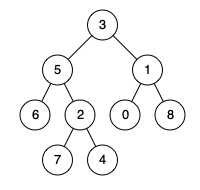2.Lowest Common Ancestor of a Binary Tree
Given a binary tree, find the lowest common ancestor (LCA) of two given nodes in the tree.
According to the definition of LCA on Wikipedia: “The lowest common ancestor is defined between two nodes p and q as the lowest node in T that has both p and q as descendants (where we allow a node to be a descendant of itself).”
Example 1:

Input: root = [3,5,1,6,2,0,8,null,null,7,4], p = 5, q = 1
Output: 3
Explanation: The LCA of nodes 5 and 1 is 3.Example 2:

Input: root = [3,5,1,6,2,0,8,null,null,7,4], p = 5, q = 4
Output: 5
Explanation: The LCA of nodes 5 and 4 is 5, since a node can be a descendant of itself according to the LCA definition.Example 3:
Input: root = [1,2], p = 1, q = 2
Output: 1Lowest common ancestor is defined between two nodes p and q as the lowest node in T that has both p and q as descendants (where we allow a node to be a descendant of itself).
Solution I
Method 1 (By Storing root to n1 and root to n2 paths): 1) Find path from root to n1 and store it in a vector or array. 2) Find path from root to n2 and store it in another vector or array. 3) Traverse both paths till the values in arrays are same. Return the common element just before the mismatch.
Time Complexity O(n), and extra space of O(n) The tree is traversed twice, and then path arrays are compared.
Solution II
Method 2 (Using Single Traversal)
Time Complexity: O(n) , Const space used.
Last updated
Was this helpful?